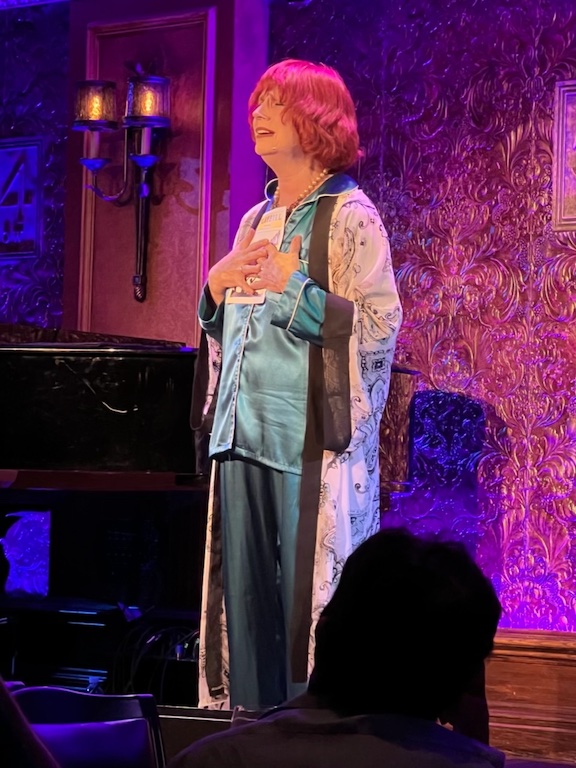By Ron Fassler . . .
“Yesterday is done.”
Is it?
In his Theory of Relativity, Einstein determined that time is relative. Or, in other words, the rate at which time passes depends on your frame of reference. With that head trip in mind, the actress/singer Ann Morrison returned with her remarkable one-person show to a welcoming audience at 54 Below last week for two performances. It’s entirely based on her experience of having starred more than forty years ago in the original Broadway production of Stephen Sondheim and George Furth’s Merrily We Roll Along. At the time, it was the sixth consecutive collaborative effort of Sondheim and the producer-director Harold Prince, preceded by Company, Follies, A Little Night Music, Pacific Overtures and Sweeney Todd, each written and produced in less than a decade that boldly redefined the American musical. By 1981, their successful partnership already stretched back twenty-five years to when West Side Story was first conceived, making Merrily a greatly anticipated musical. That it closed after sixteen performances (and forty-four previews that Morrison will tell you felt like eighty-eight), is the stuff of legend – especially since it’s generally agreed that it contains one of Sondheim’s most memorable scores, which is really saying something.

“How did you get to be here?” goes one of the lyrics from Merrily’s title song and it provides a template for the unique performance Morrison has created of her own devising. Using elements of the entire score (including some cut stuff), and sometimes changing lyrics slightly to emphasize specific moments to make them truly her own, amounts to a fascinating account on what the experience was like from her being cast on the day of her twenty-fifth birthday, to recording the cast album on the Sunday after its Saturday night closing seven months later.
Dressed somewhat inexplicably in pajamas and a silk robe (for comfortability?) and backed by the fine piano playing of John Shirley, Morrison proves that not much more than that is needed in order to take an audience captive. For eighty minutes, the stories she told (often in a self-deprecating manner), were catnip for those who can never get enough of behind-the-scenes tales of a Broadway musical in trouble, especially one that went through the upheaval Merrily did involving so many quality individuals. During its tumultuous preview period, costumes were thrown out, its leading actor was replaced by a member of the ensemble, and the choreographer was fired. Those essential five weeks (originally scheduled for three) that eschewed an out-of-town run, made for what had to have been the decision its creative team regretted most. The vicious gossip at that time, well before the age of the internet, spread like wild fire among the cognoscenti, making it almost impossible for Merrily to succeed. On a personal note, due to friendships with several members of the cast (though not Morrison), I attended its very first preview. And I can state unequivocally that in all my years of going to the theatre before or since, I’ve never heard negative buzz like that at an intermission. “What were they thinking?” was a harbinger of all that followed.


Due to the company all being under the age of twenty-five (which, come to think of it, may have been the greater everlasting regret over previewing in New York), most were making their professional debuts. With Merrily going backwards in time (ingenious in the way Sondheim composed it, if less practical in terms of George Furth’s storytelling), problems arose due to Prince’s concept of casting it with very young people, as opposed to tried and true professionals. It worked fine at the end of the show when the characters are all idealistic and young, but less so when the show begins, and they’re all jaded by their late thirties. As Morrison tells us, “When you got to the end of the play, you found out why everyone was so miserable all the time.” She also digs deep into what it meant to the youthful company rightly gob smacked at working with professionals at the level of Sondheim and Prince. After finishing her beautiful rendition of “Not a Day Goes By,” to which the audience responded with a long and loving ovation, she wisely stated, “The older you get, you really understand Sondheim.”
As a regular at 54 Below, which offers the best in cabaret performers, it was a striking change of pace to see something on its tiny stage that could easily play an off-Broadway house (which could easily happen). Make no mistake: this is a musical drama, albeit one with moments of high comedy. Any self-involved “all about me” is cast to the wayside for a highly personalized take on a major event in the careers of its participants, of which Morrison played an essential part.
In fact, the richness of this subject suggests one of my very favorite Merrily lyrics, “there’s so much stuff to sing.”
Ann Morrison: Merrily from Center Stage, was performed at 54 Below, August 19 and 20. For more calendar information, go to https://54below.com
Photos: Ron Fassler


















